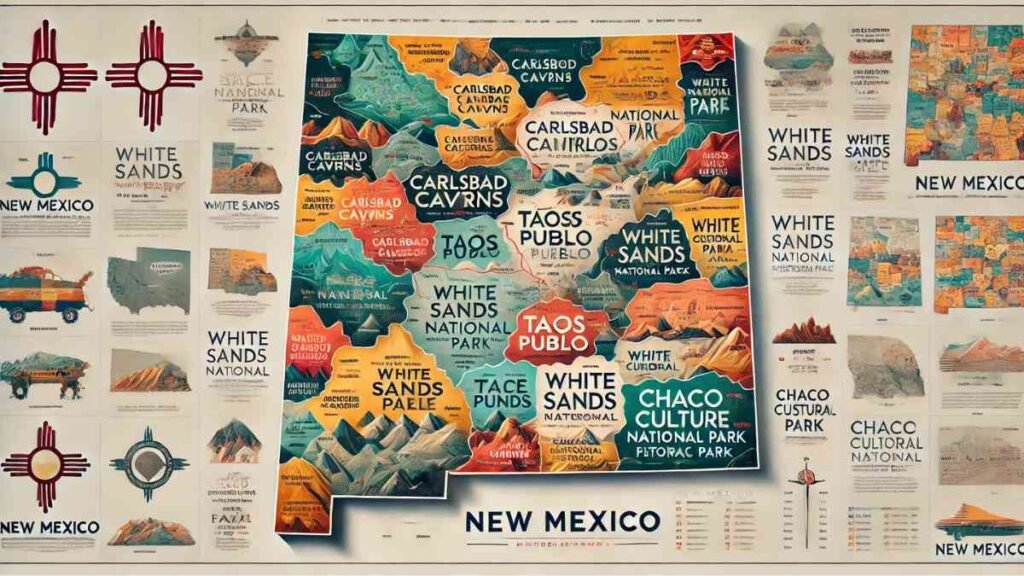Introduction
New Mexico, the “Land of Enchantment,” is a state rich in cultural history, diverse landscapes, and unique traditions. Its 33 counties offer a window into the varied geography and heritage of this fascinating region. This article delves into the history, geography, and significance of New Mexico counties, providing a detailed guide for anyone looking to explore the state.
The History of New Mexico Counties
Early Beginnings
New Mexico was organized as a U.S. territory in 1850. At that time, it was divided into nine original counties. Over the years, as settlements expanded and populations grew, new counties were established to better administer the vast area. By 1921, the current 33-county system was in place.
Evolution of Boundaries
The boundaries of many counties were drawn to reflect natural features such as rivers, mountains, and plains. Others were shaped by cultural and economic considerations, ensuring accessibility and administrative efficiency.
Geographical Diversity of New Mexico Counties
Northern Counties
The northern part of the state includes Rio Arriba, Taos, and Santa Fe counties, known for their breathtaking landscapes, including the Sangre de Cristo Mountains and Rio Grande River. Santa Fe, the state capital, is a cultural hub with rich Native American, Hispanic, and Anglo influences.
Southern Counties
Southern counties such as Doña Ana and Luna showcase a desert landscape with unique attractions like White Sands National Park. These counties are known for their agricultural contributions and proximity to the U.S.-Mexico border.
Eastern Plains
Counties like Curry and Roosevelt represent the state’s expansive eastern plains. The region is ideal for cattle ranching and farming, offering a glimpse into New Mexico’s rural charm.
Western Counties
Home to counties like McKinley and Catron, the western region features rugged terrain, ancient rock formations, and historic sites like Chaco Canyon. This area is a treasure trove for nature enthusiasts and history buffs.
Unique Features of Key Counties
Bernalillo County
- County Seat: Albuquerque
- Highlights: The most populous county in New Mexico, Bernalillo is the economic and cultural heart of the state. It’s home to Albuquerque International Balloon Fiesta, one of the world’s most famous hot air balloon events.
Los Alamos County
- County Seat: Los Alamos
- Highlights: Known for its role in the Manhattan Project, Los Alamos is a small county packed with scientific significance and outdoor activities.
Santa Fe County
- County Seat: Santa Fe
- Highlights: Santa Fe is America’s oldest state capital, offering a blend of historic adobe architecture, art galleries, and vibrant festivals.
The Role of Counties in New Mexico’s Administration
Governance and Services
Each county in New Mexico is responsible for providing essential services to its residents, such as public safety, road maintenance, and education. County governments also play a vital role in preserving the cultural and historical integrity of their regions.
Economic Contributions
Counties like Eddy and Lea in southeastern New Mexico are central to the state’s oil and gas industry, while others like Colfax and Taos rely on tourism and agriculture.
Cultural and Historical Significance of New Mexico Counties
Indigenous Heritage
Many counties, including San Juan and McKinley, are home to Native American tribes such as the Navajo Nation and Pueblo communities. These regions offer insights into ancient traditions, art, and architecture.
Hispanic Influence
Counties like Valencia and Socorro reflect New Mexico’s deep Hispanic roots, evident in their festivals, cuisine, and language. Spanish colonization has left a lasting impact on the culture and identity of the region.
Must-Visit Attractions in New Mexico Counties
- Carlsbad Caverns National Park (Eddy County): A UNESCO World Heritage Site featuring stunning limestone caves.
- Taos Pueblo (Taos County): A UNESCO-listed living Native American community.
- White Sands National Park (Otero County): The world’s largest gypsum dune field.
- Chaco Culture National Historical Park (San Juan County): Ancient ruins of a major pre-Columbian civilization.
Challenges Facing New Mexico Counties
Economic Disparities
While some counties thrive economically, others face challenges related to unemployment and limited access to resources. Rural counties often struggle to retain younger populations, who migrate to urban areas for better opportunities.
Environmental Concerns
Counties like Sierra and Luna are affected by water scarcity and climate change, impacting agriculture and local ecosystems. Efforts are ongoing to promote sustainability and resilience across the state.
Conclusion
New Mexico’s 33 counties are a testament to the state’s rich cultural and geographical diversity. Each county contributes uniquely to the identity of the “Land of Enchantment.” Whether you’re exploring the bustling streets of Albuquerque, the serene landscapes of Taos, or the historical depth of Santa Fe, New Mexico’s counties offer something for everyone.
By understanding the significance of these regions, one can appreciate the intricate tapestry that makes New Mexico truly enchanting.
For More Visit, MirrorMagazine.co.uk


